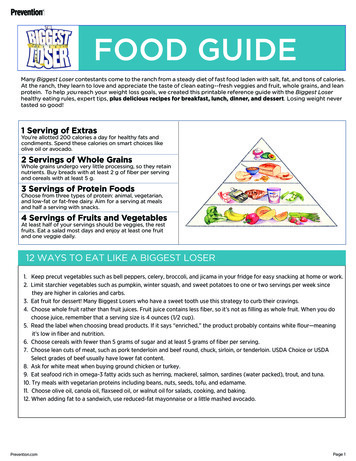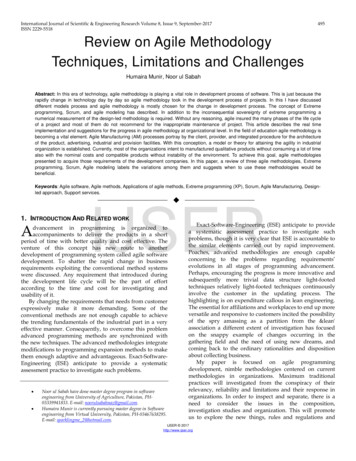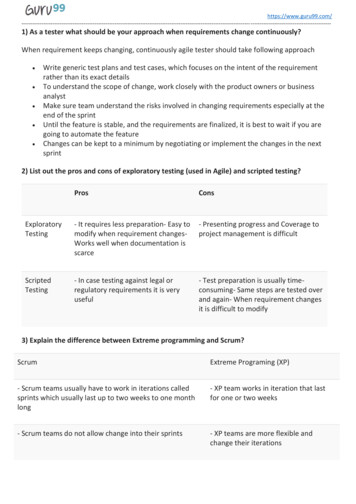
Transcription
Agile TestingAbout the TutorialAgile Testing is a software testing practice that follows the principles of agile softwaredevelopment.Agile Testing involves all members of the project team, with special expertise contributedby testers. Testing is not a separate phase and is interwoven with all the developmentphases such as requirements, design and coding and test case generation. Testing takesplace simultaneously through the Development Life Cycle.AudienceThe target audience for this tutorial is Software Testing Professionals, Software QualityExperts, and Software Developers.PrerequisitesBefore proceeding with this tutorial, you should have a basic understanding of softwaredevelopment life cycle (SDLC). A basic understanding of software testing (manual orautomation) will be beneficial.Copyright & Disclaimer Copyright 2016 by Tutorials Point (I) Pvt. Ltd.All the content and graphics published in this e-book are the property of Tutorials Point (I)Pvt. Ltd. The user of this e-book is prohibited to reuse, retain, copy, distribute or republishany contents or a part of contents of this e-book in any manner without written consentof the publisher.We strive to update the contents of our website and tutorials as timely and as precisely aspossible, however, the contents may contain inaccuracies or errors. Tutorials Point (I) Pvt.Ltd. provides no guarantee regarding the accuracy, timeliness or completeness of ourwebsite or its contents including this tutorial. If you discover any errors on our website orin this tutorial, please notify us at contact@tutorialspoint.comi
Agile TestingTable of ContentsAbout the Tutorial . iAudience . iPrerequisites . iCopyright & Disclaimer . iTable of Contents . ii1.Agile Testing – Overview . 1Agile Manifesto. 1What is Agile Testing? . 1Agile Testing Vs. Waterfall Testing . 2Agile Testing Principles . 2Agile Testing Activities . 42.Agile Testing – Agile Methodologies . 5Continuous Integration, Continuous Quality . 5Agile Methodologies. 6Agile Testing Methodologies . 7Agile Testing Lifecycle . 83.Agile Testing – Tester in Agile Team . 9Role of Tester in Agile Team . 104.Agile Testing – Tracking Testing Activities . 13Test Progress . 13Product Quality. 13Key Success Factors . 145.Agile Testing – Significant Attributes . 16Agile Testing Benefits . 16Best Practices in Agile Testing . 16Challenges in Agile Testing . 17Agile Testing Guidelines . 186.Agile Testing – Quadrants . 197.Agile Testing in Scrum . 23Collaborative User Story Creation . 23Agile Testing Practices . 258.Agile Testing Methods . 27Test Driven Development . 27Acceptance Test Driven Development . 27Behavior Driven Development (BDD) . 289.Agile Testing – Techniques . 29Definition of Done . 29Test Information . 30Functional and Non-Functional Test Design . 30Exploratory Testing . 31Risk-Based Testing . 31Fit Tests. 31ii
Agile Testing10. Agile Testing Workproducts . 32Test Metrics Reports . 33Sprint Review and Retrospective Reports . 3411. Agile Testing in Kanban . 35Testing Activities in Product Development . 35Story Exploration . 36Estimation . 36Story Planning. 37Story Progression. 37Story Acceptance . 3712. Agile Testing – Tools . 38Agile Test Automation Tools . 39iii
Agile Testing – OverviewAgile TestingAgile is an iterative development methodology, where both development and testingactivities are concurrent. Testing is not a separate phase; Coding and Testing are doneinteractively and incrementally, resulting in quality end product, which the meets customerrequirements. Further, continuous integration results in early defect removal and hence time,effort and cost savings.Agile ManifestoThe Agile Manifesto was published by a team of software developers in 2001, highlighting theimportance of the development team, accommodating changing requirements and customerinvolvement.The Agile Manifesto is:We are uncovering better ways of developing software by doing it and helping others do it.Through this work, we have come to value Individuals and interactions over processes and tools. Working software over comprehensive documentation. Customer collaboration over contract negotiation. Responding to change over following a plan.That is, while there is value in the items on the right, we value the items on the left more.What is Agile Testing?Agile Testing is a software testing practice that follows the principles of agile softwaredevelopment.Agile Testing involves all members of the project team, with special expertise contributed bytesters. Testing is not a separate phase and is interwoven with all the development phasessuch as requirements, design and coding and test case generation. Testing takes placesimultaneously through the Development Life Cycle.Furthermore, with testers participating in the entire Development Lifecycle in conjunction withcross-functional team members, the contribution of testers towards building the software asper the customer requirements, with better design and code would become possible.Agile Testing covers all the levels of testing and all types of testing.4
Agile TestingAgile Testing Vs. Waterfall TestingIn a Waterfall Development methodology, the Development Life Cycle activities happen inphases that are sequential. Thus, testing is a separate phase and gets initiated only after thecompletion of the development phase.Following are the highlights of differences between Agile Testing and Waterfall TestingAgile TestingWaterfall TestingTesting is not a separate phase andoccurs concurrently with development.Testing is a separate phase. All levels andtypes of testing can begin only after thecompletion of development.Testers and developers work together.Testers work separately from developers.Testers are involved in coming up withrequirements. This helps in requirementsmapping to the behaviors in the realworld scenario and also framing theacceptancecriteria.Also,logicalAcceptance Test Cases would be readyalong with the requirements.Testers may not berequirements phase.Acceptance Testing is done after everyiteration and customer feedback issought.Acceptance Testing is done only at the endof the project.Every iteration completes its own testingthus allowing regression testing to beimplemented every time new functions orlogic are released.Regression Testing can be implemented onlyafter the completion of development.No time delays between coding andtesting.Usual time delays between coding andtesting.Continuous testing with overlapping testlevels.Testing is a timed activity and test levelscannot overlap.Testing is a best practice.Testing is often overlooked.involvedintheAgile Testing PrinciplesThe principles of Agile testing are Testing moves the project forward: Continuous testing is the only way to ensurecontinuous progress. Agile Testing provides feedback on an ongoing basis and the finalproduct meets the business demands.5
Agile Testing Testing is not a phase: Agile team tests alongside the development team to ensurethat the features implemented during a given iteration are actually done. Testing isnot kept for a later phase. Everyone tests: In agile testing, the entire team including analysts, developers, andtesters test the application. After every iteration, even the customer performs the UserAcceptance Testing. Shortening Feedback Loops: In Agile Testing, the business team get to know theproduct development for each and every iteration. They are involved in every iteration.Continuous feedback shortens the feedback response time and thus the cost involvedin fixing it is less. Keep the Code Clean: The defects are fixed as they are raised within the sameiteration. This ensures clean code at any milestone of development. Lightweight Documentation: Instead of comprehensive test documentation, AgiletestersoUse reusable checklists to suggest tests.oFocus on the essence of the test rather than the incidental details.oUse lightweight documentation styles/tools.oCapture test ideas in charters for exploratory testing.oLeverage documents for multiple purposes. Leveraging one test artifact for manual and automated tests: Same test scriptartifact can be utilized for manual testing and as an input for automated tests. Thiseliminates the requirement of Manual Test Documentation and then an equivalentAutomation Test Script. “Done Done,” not just done: In Agile, a feature is said to be done not afterdevelopment but after development and testing. Test-Last vs. Test Driven: Test Cases are written along with the requirements.Hence, development can be driven by testing. This approach is called Test DrivenDevelopment (TDD) and Acceptance Test Driven Development (ATDD). This is incontrast to testing as a last phase in Waterfall Testing.6
Agile TestingAgile Testing ActivitiesThe Agile Testing Activities at Project Level are Release Planning (Test Plan)oFor every Iteration,oAgile Testing Activities during an Iteration Regression Testing Release Activities (Test Related)The Agile Testing Activities during an iteration include Participating in iteration planning Estimating tasks from the view of testing Writing test cases using the feature descriptions Unit Testing Integration Testing Feature Testing Defect Fixing Integration Testing Acceptance Testing Status Reporting on Progress of Testing Defect Tracking7
Agile Testing – Agile MethodologiesAgile TestingAgile is an iterative development methodology, where the entire project team participates inall the activities. The requirements evolve as the iterations progress, through collaborationbetween the customer and the self-organizing teams. As Coding and Testing are doneinteractively and incrementally, during the course of development, the end-product would beof quality and ensures customer requirements.Every iteration results in an integrated working product increment and is delivered for UserAcceptance Testing. The customer feedback thus obtained would be an input to the next /subsequent Iterations.Continuous Integration, Continuous QualityContinuous Integration is the key for Agile Development success. Integrate frequently, atleast daily such that you are ready for a release as and when required. Testing in Agilebecomes an essential component of all the phases of the development, ensuring continuousquality of the product. Constant feedback from everyone involved in the project adds to thequality of the product.In Agile, communication is given utmost importance and the customer requests are receivedas and when necessary. This gives the satisfaction to the customer that all the inputs areconsidered and working quality product is available throughout the development.8
Agile TestingAgile MethodologiesThere are several Agile Methodologies that support Agile Development. The AgileMethodologies include-ScrumScrum is an Agile development method that emphasizes on team-centric approach. Itadvocates participation of the entire team in all the project development activities.XPeXtreme Programming is customer-centric and focuses on constantly changing requirements.With frequent releases and customer feedback, the end-product will be of quality meetingcustomer requirements that are made clearer during the process.CrystalCrystal is based on chartering, cyclic delivery and wrap up. Chartering involves forming a development team, carrying out a preliminary feasibilityanalysis, arriving at an initial plan and the development methodology.Cyclic Delivery with two or more delivery cycles focuses on the development phaseand final integrated product delivery.During Wrap up, deployment into the user environment, post-deployment reviews andreflections are performed. FDDFeature Driven Development (FDD) involves designing and building features. The differencebetween FDD and other Agile Development Methodologies is that the features are developedin specific and short phases separately.DSDMDynamic Software Development Method (DSDM) is based on Rapid Application Development(RAD) and is aligned to the Agile Framework. DSDM focuses on frequent delivery of theproduct, involving users actively and empowering the teams to make quick decisions.Lean Software Development9
Agile TestingIn Lean Software Development, focus is on eliminating waste and giving value to thecustomer. This results in rapid development and product of value.Waste includes partially done work, irrelevant work, features that are not used by thecustomer, defects, etc. that add to delays in delivery.The Lean Principles are Eliminate Waste Amplify Learning Delay Commitment Empower the Team Deliver Fast Build Integrity in See the WholeKanbanKanban focuses on managing work with an emphasis on just-in-time (JIT) delivery, while notoverloading the team members. The tasks are displayed for all the participants to see and forthe Team Members to pull work from a queue.Kanban is based on: Kanban Board (Visual and Persistent across the Development) Work-in-progress (WIP) Limit Lead TimeAgile Testing MethodologiesThe testing practices are well defined for every project, whether Agile or not, to deliver qualityproducts. Traditional Testing principles are quite often used in Agile Testing. One of them isEarly Testing that focuses on Writing Test Cases to express the behavior of the system. Early Defect Prevention, detection and removal. Ensuring that the right test types are run at the right time and as part of the right testlevel.In all the Agile Methodologies we discussed, Agile Testing in itself is a Methodology. In all theapproaches, Test Cases are written before Coding.In this tutorial, we will focus on Scrum as the Agile Testing Methodology.10
Agile TestingThe other commonly used Agile Testing Methodologies are Test-Driven Development (TDD): Test-Driven Development (TDD) is based oncoding guided by tests. Acceptance Test-Driven Development (ATDD): Acceptance Test-DrivenDevelopment (ATDD) is based on communication between the customers, developersand testers and driven by pre-defined Acceptance Criteria and Acceptance Test Cases. Behavior-Driven Development (BDD): In Behavior-Driven Development (BDD)testing is based on the expected behavior of the software being developed.11
Agile TestingEnd of ebook previewIf you liked what you saw Buy it from our store @ https://store.tutorialspoint.com12
Agile Manifesto The Agile Manifesto was published by a team of software developers in 2001, highlighting the importance of the development team, accommodating changing requirements and customer involvement. The Agile Manifesto is: We are uncovering better ways of developing software by doing it and helping others do it.










